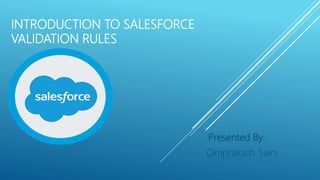Introduction to Salesforce validation rules new
•Descargar como PPTX, PDF•
1 recomendación•1,250 vistas
Denunciar
Compartir
Denunciar
Compartir

Recomendados
Recomendados
Más contenido relacionado
La actualidad más candente
La actualidad más candente (20)
Lightning web components - Episode 1 - An Introduction

Lightning web components - Episode 1 - An Introduction
Salesforce administrator training presentation slides 

Salesforce administrator training presentation slides
Understanding Multitenancy and the Architecture of the Salesforce Platform

Understanding Multitenancy and the Architecture of the Salesforce Platform
Similar a Introduction to Salesforce validation rules new
Similar a Introduction to Salesforce validation rules new (20)
Manual for Troubleshooting Formulas & Functions in Excel

Manual for Troubleshooting Formulas & Functions in Excel
Week 3 Lecture 11 Regression Analysis Regression analy.docx

Week 3 Lecture 11 Regression Analysis Regression analy.docx
142500146 using-oracle-fast formula-for-payroll-calculations

142500146 using-oracle-fast formula-for-payroll-calculations
[M3A3] Data Analysis and Interpretation Specialization ![[M3A3] Data Analysis and Interpretation Specialization](data:image/gif;base64,R0lGODlhAQABAIAAAAAAAP///yH5BAEAAAAALAAAAAABAAEAAAIBRAA7)
![[M3A3] Data Analysis and Interpretation Specialization](data:image/gif;base64,R0lGODlhAQABAIAAAAAAAP///yH5BAEAAAAALAAAAAABAAEAAAIBRAA7)
[M3A3] Data Analysis and Interpretation Specialization
BUS 308 Week 4 Lecture 3 Developing Relationships in Exc.docx

BUS 308 Week 4 Lecture 3 Developing Relationships in Exc.docx
REGRESSION ANALYSISPlease refer to chapter 3 of the textbook fo.docx

REGRESSION ANALYSISPlease refer to chapter 3 of the textbook fo.docx
Here are the 16 pricing elements in pricing procedure and description for each

Here are the 16 pricing elements in pricing procedure and description for each
ETL Validator Usecase - Validating Measures, Counts with Variance

ETL Validator Usecase - Validating Measures, Counts with Variance
Introduction to Salesforce validation rules new
- 1. INTRODUCTION TO SALESFORCE VALIDATION RULES Presented By: Omprakash Saini
- 2. Validation rules verify that the data a user enters in a record meets the standards you specify before the user can save the record. A validation rule can contain a formula or expression that evaluates the data in one or more fields and returns a value of “true” or “false”. Validation rules also include an error message to display to the user when the rule returns a value of “true” due to an invalid value. WHAT IS A VALIDATION RULE:
- 3. .The user chooses to create a new record or edit an existing record. .The user clicks save. . All validation rules are verified. .If all data is valid, the record is saved. .If any data is invalid, the associated error message displays without saving the record. .The user makes the necessary changes and clicks save again AFTER YOU HAVE DEFINED VALIDATION RULES:-
- 4. 1. Make fields conditionally required, depending on the value of another field. 2.Ensure that numbers are within a specified range, such as discount is less than 30%. 3. Enforce that date fields are the correct chronological sequence, such as start date is before end date. EXAMPLE USES:-
- 5. AND:- Returns a TRUE response if all values are true, returns a FALSE response if one or more values are false. Use this as an alternative to the operator && (AND). FORMULA FIELD EXAMPLE: IF (and(price<1,quantity<1),"small", null) This formula displays “small” if the price and quantity are less than one. This field is blank if the asset has a price or quantity greater than one. WE CAN USE THESE DIFFERENT FORMULAS TO DEFINE VALIDATION RULES:-
- 6. ABS:- Calculates the absolute value of a number. The absolute value of a number is the number without its positive or negative sign. USE: ABS (number) and replace number with a merge field, expression, or other numeric value that has the sign you removed. EXAMPLE: ABS(ExpectedRevenue) calculates the positive value of the expected revenue amount regardless of whether it is positive or negative.
- 7. CASE:- Checks a given expression against a series of If the expression is equal to a value, returns the corresponding result. If it is not equal to any values, it returns the else_result. USE: CASE (Expression, value1, result1, value2, result2,...,Else_result) EXAMPLE: Days open for cases use this example of a custom formula field called days open to display different text depending on the number of days a case has been open: case(days_open__c, 3,"reassign", 2, "assign task", "maintain")
- 8. CONTAINS:- Compares two arguments of text and TRUE if the first argument contains the second argument. not, returns FALSE. USE: CONTAINS(TEXT, compare_text) EXAMPLE: IF(CONTAINS(product_type__c, "part"), "parts","service") This formula checks the content of a custom text field named product_typeand returns “parts” for any product with the word “part” in it. Otherwise, it returns“service.” Note that the values are case sensitive.
- 9. IF:- Determines if expressions are true or false. Returns given value if true and another value if false. USE: IF (logical_test, value_if_true, value_if_false) EXAMPLE:IF(AND(payment_due_date__c < TODAY(), payment_status__c="unpaid"), "PAYMENT OVERDUE", null) This formula determines if the payment due date is and the payment status is “UNPAID.” If so, returns the text “PAYMENT OVERDUE” and if not, leaves the field blank.
- 10. NOT:- Returns FALSE for TRUE and TRUE for USE: NOT(LOGICAL) And replace logical With the expression that you want evaluated. EXAMPLE: IF(NOT(ISPICKVAL(STATUS, "CLOSED")) ROUND(NOW()Createddate,0), null checks to see if a variable is open and if so, calculates the number days it has been open by subtracting the date and time created from the current date and time. The result is the number of days open rounded to zero decimal places. If the variable is not open, this field blank.
- 11. THANK YOU…